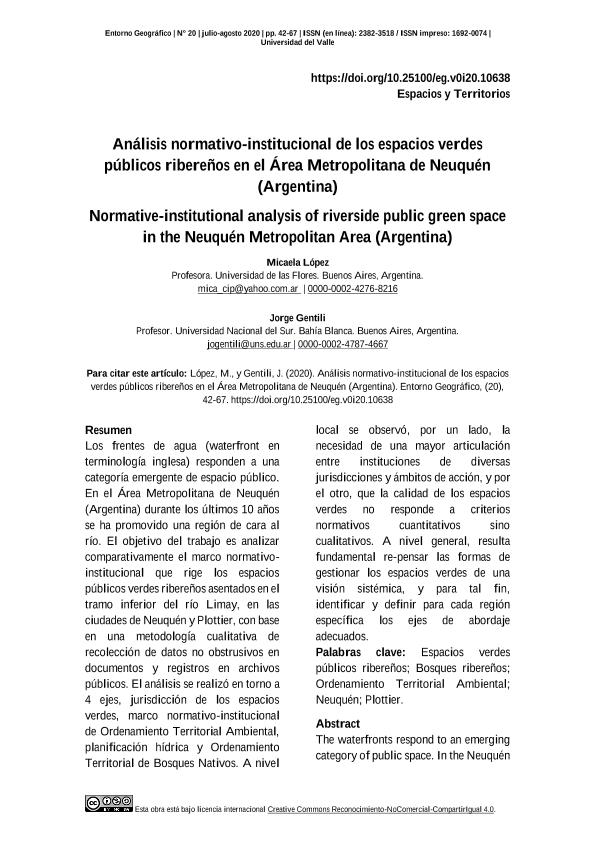Artículo
Los frentes de agua (waterfront en terminología inglesa) responden a una categoría emergente de espacio público. En el Área Metropolitana de Neuquén (Argentina) durante los últimos 10 años se ha promovido una región de cara al río. El objetivo del trabajo es analizar comparativamente el marco normativo-institucional que rige los espacios públicos verdes ribereños asentados en el tramo inferior del río Limay, en las ciudades de Neuquén y Plottier, con base en una metodología cualitativa de recolección de datos no obstrusivos en documentos y registros en archivos públicos. El análisis se realizó en torno a 4 ejes, jurisdicción de los espacios verdes, marco normativo-institucional de Ordenamiento Territorial Ambiental, planificación hídrica y Ordenamiento Territorial de Bosques Nativos. A nivel local se observó, por un lado, la necesidad de una mayor articulación entre instituciones de diversas jurisdicciones y ámbitos de acción, y por el otro, que la calidad de los espacios verdes no responde a criterios normativos cuantitativos sino cualitativos. A nivel general, resulta fundamental re-pensar las formas de gestionar los espacios verdes de una visión sistémica, y para tal fin, identificar y definir para cada región específica los ejes de abordaje adecuados. The waterfronts respond to an emerging category of public space. In the Neuquén Metropolitan Area (Argentina), for the last 10 years, a region facing the river has been promoted. The objective of the work is to comparatively analyze the normative-institutional framework that governs the green public riparian spaces located in the lower section of the Limay river, in the cities of Neuquén and Plottier, based on a qualitative methodology for collecting non-obstrusive data in documents and records in public files. The analysis was carried out around 4 axes, jurisdiction of green spaces, normative-institutional framework of territorial environmental ordering, water planning and territorial ordering of native forests. At the local level, it was observed, on the one hand, the need for greater coordination between institutions from different jurisdictions and spheres of action, and on the other, that the quality of green spaces does not respond to quantitative but rather qualitative normative criteria. At a general level, it is essential to rethink the ways of managing green spaces from a systemic vision, and for this purpose, identify and define for each specific region the appropriate approach axes.
Análisis normativo-institucional de los espacios verdes públicos ribereños en el Área Metropolitana de Neuquén (Argentina)
Título:
Normative-institutional analysis of riverside public green space in the Neuquén Metropolitan Area (Argentina)
Fecha de publicación:
12/2020
Editorial:
Universidad del Valle
Revista:
Entorno Geográfico
ISSN:
1692-0074
e-ISSN:
2382-3518
Idioma:
Español
Tipo de recurso:
Artículo publicado
Clasificación temática:
Resumen
Archivos asociados
Licencia
Identificadores
Colecciones
Articulos(IPEHCS)
Articulos de INSTITUTO PATAGONICO DE ESTUDIOS DE HUMANIDADES Y CIENCIAS SOCIALES
Articulos de INSTITUTO PATAGONICO DE ESTUDIOS DE HUMANIDADES Y CIENCIAS SOCIALES
Citación
Lopez, Micaela; Gentili, Jorge Osvaldo; Análisis normativo-institucional de los espacios verdes públicos ribereños en el Área Metropolitana de Neuquén (Argentina); Universidad del Valle; Entorno Geográfico; 20; 12-2020; 42-67
Compartir
Altmétricas




